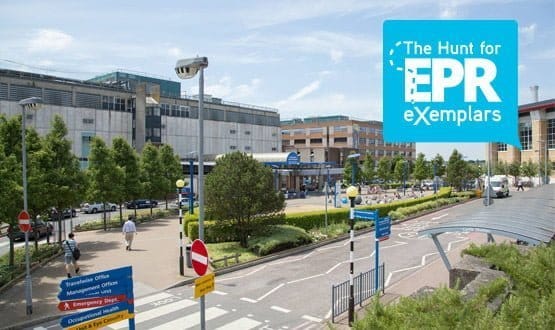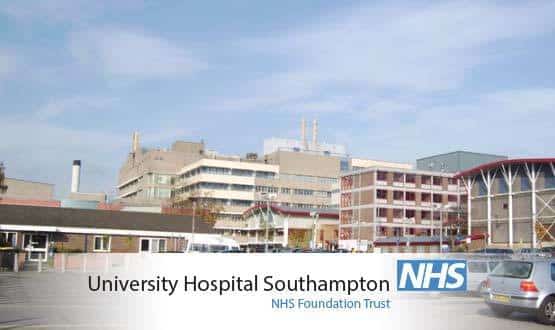Saints alive
- 8 October 2013

In the specimen reception area of Southampton’s laboratory, a box of samples waits to be sorted and scanned.
Staff in white coats scan a barcode if the specimen has been collected in hospital, or enter the information if it has come via a GP.
All the patient’s details are then pulled directly into University Hospital Southampton NHS Foundation Trust’s laboratory system, from where staff can see the progress of any test they have requested.
When a result comes through, clinicians can view it and, depending on their role, acknowledge that they have seen and acted upon it.
Adrian Byrne, University Hospital Southampton’s director of IM&T, says the trust places a particular focus on this kind of ‘closed loop reporting’.
He recounts an incident from years ago, when a doctor used the lab system to review a patient’s blood results. The clinician believed he was looking at the most up-to-date information but, tragically, he was not.
A new result showing the patient had meningitis was missed and the patient died. “What I have always looked out for, ever since, is areas where things can fall down a hill,” Byrne says.
However, making sure they don’t is not always easy. Southampton has been working on creating a closed loop of results reporting and acknowledgment for the past seven years, ever since it deployed order communications.
“These things are really difficult to implement, because what we found was that it is not just doctors that order a test: it’s a team,” Byrne explains. “But you can’t assume that anyone from a team can acknowledge it.”
This kind of experience also makes him wary of some approaches to creating an electronic patient record. “We are very nervous about things that, for example, stick a portal over everything,” he says.
“It can give a false impression of an electronic patient record. It’s easy to skirt over issues [such as who acknowledges, not just gets, results] and think there’s an EPR when there isn’t.”
On the ground
Southampton is taking a multi-vendor approach to building its EPR. Prior to 2000, the trust had around 300 stand-alone systems, many of which did not talk to one another.
It put in place a ‘Millennium’ programme of work to replace many of these systems and to put those that remained within a common data model.
“That was quite a revolutionary step. We went to tender to find someone, as we wanted a web-based front-end. It was quite hard to get people to work with us, so in the end we had to do it ourselves, using consultants,” explains Byrne.
These sort of collaborative, in-house developments are central to the trust’s EPR history. Two key systems it has built are an order communications system called eQuest and an electronic document creation system called eDocs, which stores 10m records going back to 1996.
The consultancy company it worked with, Scorpio Information Systems, was later bought by Ascribe, which now does all the builds for Southampton. Occasionally, the trust will buy a product off-the-shelf and integrate it into the EPR.
The trust uses about 60 Ascribe systems and 100 from other vendors. The aim is to have those that are not integrated into the EPR produce summary information documents that are stored in eDocs.
Having got the majority of the systems that it wants in place, Southampton is moving towards a clinical data repository model using Ascribe’s health application platform and a vendor neutral archive from Acuo.
“CDRM we like because it takes away from having to build complex interfacing for all the data,” says Byrne.
“The vision is we will be paperless, have a consistent user interface, one log-on and no multiple searches for patients, plus we will be able to surface all the data within the workflow.”
Paper case notes are still used on inpatient wards in Southampton’s hospitals, but the majority of ordering and requesting is done electronically, with the IT team adding 27 referral types to the system over the past three months. About 80% of outpatient clinics now run without paper case notes.
Lessons learned
Under the news stories and features that EHI has been running on trusts that might be regarded as EPR exemplars, Byrne has argued that his trust’s approach raises interesting questions about what should count as ‘exemplardom.’
While the idea of the series is to identify trusts from which others can learn, it has thrown up questions such as how integrated and extensive their systems should be, and whether its approach has to be replicable in order for it to count.
Byrne sees many benefits to single solutions. But Southampton has been building its EPR ecology for 15 years, so it can hardly throw away everything it has done.
It would also be difficult for another trust to simply take one of Southampton’s systems and “drop it in” to its own IT environment.
Still, Byrne argues there are a number of lessons that his trust has learned that could be taken on-board by those embarking on their own EPR journey.
“We have tended to involve users very early on and tended to deliver things that they tell us that they need,” he says. “We have to deliver them something that’s usable; the concept of just delivering functionality isn’t really good enough.”
Board and clinical buy-in
Byrne says that while the executive team is supportive of the EPR development, the board “has not necessarily bought into that idea that technology won’t always have a return on investment.”
Fortunately: “We have some powerful clinical leaders who support what we do.” One of these is deputy medical director Derek Waller, who has championed the creation of the ‘Doctor’s Worklist’.
The idea behind this is to give clinicians one log-on, which provides a single point of access for systems and drives a list of their patients and jobs for a day.
Clinicians can see key a patient’s medical history via the Hampshire Health Record – a local care summary, fed by GP and other systems – order tests and access the JAC e- prescribing system.
“You have instant access to such a wide variety of things where previously it was hit or miss about whether you got the patient’s history or separate specialist notes,” says Waller.
Clinicians can see the worklist via a ward view, team view or consultant view, making sure that everyone is informed about each patient on a ward and their care needs, and allowing for a standardised handover at the end of each day.
Doctors can log-in remotely, view results and give medical advice. The worklist also alerts clinicians as to whether a patient needs a blood clot (VTE) or dementia assessment, turning green when this has been done. The IT team recently won the trust’s “team of the month” award for this functionality.
Remembering the bad old days
Southampton’s A&E is yet to go paperless, with administration done on paper then scanned into the Symphony system. Waller says going digital is dependent on making mobile devices available to all staff, who are under pressure to meet the government’s four-hour A&E wait time target.
However, A&E consultant Dr Beata Brown explains that the digitisation of patient information means that she does up to 80% of her work electronically, when not long ago she did 100% on paper.
Dr Brown sits at a central bank of computer terminals as she explains that Doctor’s Worklist halves the time it takes for her to access information about a patient, as well as giving her access to information she could not previously get.
“It does require some adjustment, you have to change the way you think and work,” she explains. “But I think it’s great – excellent.”
Respiratory medicine consultant Dr Anindo Banerjee is also happy to give his views on the EPR, as he makes his way along a hallway. He says online line electronic respiratory requesting and reporting has made a “huge difference” to his working life.
“In the bad old days we were scrabbling through notes, trying to find bits of paper, and finding some had gone missing. Now I can look up (a patient) and get retrospective data going back years, so I can make better decisions at any moment,” he says.
On ward rounds, doctors use computers-on-wheels or netbooks to access the worklist. The big complaint they have is the heaviness of their kit.
Junior doctor Sarah Gowingsays it is great each team as its own laptop, but she would like something less “clunky” to carry around all day. She uses Doctor’s Worklist to see what jobs need doing for which patient.
Having worked in other hospitals, she says this is usually done entirely on paper and she believes having the electronic system improves her efficiency. “That probably does have patient safety implications because we have more time,” she tells EHI.
Other parts of the puzzle
Southampton is looking to introduce open source nursing observation system WardWare, developed by Tactix4. Once in place, this will mean clinicians can see a patient’s vital signs and trends within Doctor’s Worklist.
Other systems on the horizon include a bed management system and electronic document management system, which Byrne plans to have in place by 2018. The trust does e-prescribing for inpatients and will start rolling it out to outpatients next year.
In all of this, Byrne stresses again that usability has to be paramount. “The difference between success and failure can amount to one or two mouse clicks,” he points out. “You have to get that right.”




